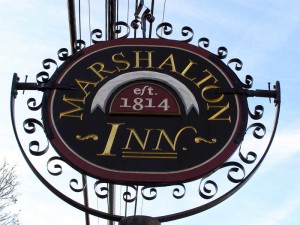By Gene Pisasale, Special to The Times

Martin’s Tavern played a key role in the Revolutionary War and went on to become a central location in Marshallton for almost 200 years.
Visitors to Chester County know the area for its rolling hills and a kaleidoscope of colors in the Fall, but few are deeply familiar with its rich heritage dating back well over 300 years. William Penn made the first land transfers to settlers, Chester County archives showing 1,250 acres “to be taken up in his said Province” which were granted to Mary Penington in 1681. West Bradford township was organized in 1705 and contains three historic districts including the town of Marshallton, named after Humphry Marshall, whose 1773 home still stands. Marshall was one of America’s first botanists, selling plants to Washington, Jefferson and other Founding Fathers. The earliest residents of the area were Quaker farmers, some of whom would inadvertently play a role in the Revolutionary War, with names like Trimble’s ford and Jeffries ford influencing troop movements during the Battle of the Brandywine on September 11, 1777.
Along the main street of Marshallton stand the remains of Martin’s Tavern (originally known as the Center House), which hosted local militia members John Hannum and Squire Thomas Cheyney at a critical time in our nation’s history. Hannum and Cheyney witnessed a large British force marching near the forks of the river after spending the night at the tavern on September 10, 1777. Determined to get this crucial information to George Washington, they both rode at full gallop towards Chadds Ford. Cheyney reached the commander first, allowing him to avoid a disaster at the hands of the British. After nearly 200 years of use, the structure was preserved and stabilized in 2005 by the Friends of Martin’s Tavern.

Because of a deed error, the Marshalton Inn isn’t spelled the same as the neighborhood name, but it does share a rich history with the area.
Aside from agriculture, the region had blacksmiths, coopers, shoemakers and wheelwrights who plied their trades near the bustling Strasburg Road. The blacksmith shop, built in 1750 and refurbished in the early 1970s by Mary Evans, is a well preserved example of Colonial-era architecture. The current Marshalton Inn (spelled with only one “l” due to a typographic error on a deed transfer) has been witness to over two centuries of history. The Federal-style structure was built by Joseph Woodward in 1793 as a residence. A year later, with the upgrading of the Strasburg state road, travelers flocked to the area. Aside from the Lancaster Turnpike (Lincoln Highway), the Strasburg Road was the only major thoroughfare from Philadelphia to Pittsburgh. Teamsters who wished to avoid paying tolls on the turnpike often used this road and local traffic increased sharply.
It became apparent that Marshallton needed another establishment to accommodate travelers. In 1802, Abraham Martin bought the property and after eleven years of refurbishing, the stone house was ready for tavern status. However, when Martin applied for a license to operate a “publick house”, locals objected, claiming the neighborhood would be disrupted by mischief. Martin was finally granted a license and named it the Sign of the General Wayne, after Revolutionary War hero Anthony Wayne. The tavern was re-named the Marshalton Inn in the 1960’s and placed on the National Register of Historic Places in 1977.
During its existence, the inn has had more than 25 owners, including a book lover named Tom Baldwin (current owner of the historic Baldwin’s Book Barn) who purchased the aging structure in 1964. With the help of Williamsburg architect George Fletcher Bennett, the tavern was completely refurbished. In 1979, owners of the Marshalton Inn converted the building across the parking lot (which had been used as stables for the Inn’s horses) into the Oyster Bar, a popular watering hole. Renovated in 1996, the Oyster Bar was re-named the Four Dogs Tavern. A sign based on a painting by 19th century French artist Louis Godefroy Jadin depicting playful canines greets visitors.
Aside from good food and live music, visitors can find newly laid red brick pavements leading to structures from yesteryear, including the Grange Building, once the meeting place for the community. Nearby is the Bradford Friends Meeting House, welcoming worshippers since 1726. The adjacent cemetery contains the remains of Nathan Sims, a young black boy who has a curious place in our nation’s heritage. He held the reins for John Wilkes Booth’s horse at Ford’s Theatre in Washington, D.C. while Booth carried out the assassination of Abraham Lincoln. Sims later told authorities which direction Booth headed, redeeming himself by helping to capture the greatest traitor in American history. Marshallton can also claim fame from two well known residents. Charles Mason and Jeremiah Dixon lived nearby at the Harlan Farm while surveying the Mason-Dixon Line from a point of astrological observation called the “Stargazer’s Stone”.
If you find yourself in the beautiful countryside of Chester County, take some time to visit Marshallton. You’ll be pleased with its small town persona. Relax in the quiet surroundings of this Colonial-era treasure. You can almost hear the clip-clop of hoofs in the distance, horses whose riders saved a young General from impending doom … and others who simply had a long trip along the dusty, old Strasburg Road, needing some refreshment in a town which has greeted visitors for nearly three centuries.
To learn more about the author, visit his website at www.GenePisasale.com or email him at Gene@GenePisasale.com.






